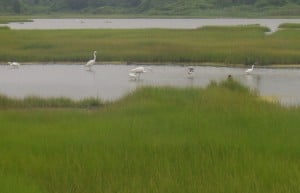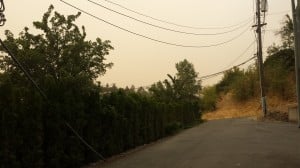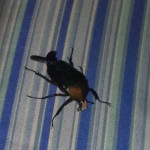Last week I moved about 25 miles from Berkeley to Union City. I’ll be here for the next week until I head back to the UK for another 2 week visit. Over the weekend I decided that I wanted to take a hike around the area where I’m staying. Unfortunately, when I set out to take that hike, I was blocked by fences and gates at every border between the suburban neighborhood and the “wild”.
 This area is mostly recently built up with developments of single family dwellings. There are front and back yards on nearly every house, many with well manicured rose gardens or fruit trees. In the evening the air comes alive with the sound of crickets and frogs. There’s wildlife here, but it’s mostly hidden from the human residents. I have spent some time sitting in my friend’s backyard quietly waiting for the birds to ignore me, but I wanted to get just a little bit further away from the peopled spaces. I wanted to see what was living just a few blocks away where no one sprays roundup on their lawns.
This area is mostly recently built up with developments of single family dwellings. There are front and back yards on nearly every house, many with well manicured rose gardens or fruit trees. In the evening the air comes alive with the sound of crickets and frogs. There’s wildlife here, but it’s mostly hidden from the human residents. I have spent some time sitting in my friend’s backyard quietly waiting for the birds to ignore me, but I wanted to get just a little bit further away from the peopled spaces. I wanted to see what was living just a few blocks away where no one sprays roundup on their lawns.
I saw on Google Maps that there are walkways just a few blocks away that go through what look like empty fields and salt marshes. I planned to hike out there in the early afternoon, enjoying the Spring sun and comfortable temperatures. On Saturday morning I did some housework, played with my friend’s kids, and then headed out for my little adventure. I walked the few blocks to the edge of the housing development only to arrive at a high fence. I’d seen a park just to the North in the satellite pictures, and it had clear pathways out into the fields and marshes. So I headed along the edge of the neighborhood toward the park.
Arriving at the park, I found the trail that I expected. I walked past the group of mostly immigrant cricket players in this California baseball field, and right to the edge of the park. The path continued onward, but I couldn’t go any further. A fence had been erected right across the walkway at the boundary between the park and the wilderness. Just on the other side of the fence was a small pond with some geese paddling around contentedly. I couldn’t sit near the pond or see what small plants grew in the ground around it. I could only watch with my nose pressed into the links of the fence.
For the next hour I walked onward, trying other possible entrances based on the map, always finding a large locked gate or an unbroken fence. As my failure to get out of the suburban zone continued, my mind wandered to the political ramifications of fences and blocking off pathways through fields and wilderness. I thought about the book I told you about last week, Tending the Wild, and the other books I’ve read recently about issues of indigenous rights and colonialism. I thought about how the enclosure movement in the UK took away traditional rights to the commons and forced people away from their traditional way of life and into factory and domestic work.
Ironically, I’d always taken fences as a given growing up. My dad and I went hiking a lot and I knew that we could only walk on certain paths in certain places because everything else was “private property” or “federal property” and fenced off to keep people out. It was only when I lived in England in the early 00’s that I found out about the UK’s national network of footpaths and realized what an amazing treasure it is to have the right of way to walk respectfully across fields and gardens for miles and miles and miles.
There is a problem, a controversy that I haven’t quite solved in my own head, regarding fences or the lack thereof. There are many reasons for fences, and some of them may be good. Or not.
For instance, one of the fenced off areas near the marshes has cell phone towers in it. I’m pretty sure that the owners of those towers are concerned about vandalism. I like being able to use my cell phone. Maybe it’s good for that to be fenced off. Or maybe its better to have the tower in a place where there are more people around to dissuade vandals from their mischief.
Another example: The salt marshes and the area around them are important ecological resources. Maybe by keeping people out of them we are protecting them and ourselves. Or maybe those zones aren’t really protected at all — there are no signs around saying it’s a preserve, after all. Maybe those zones are just being fenced off for the private use of corporations like the one that owns the cell tower. And maybe the area needs people, not as interference but in the sense of healthy interaction.
One hundred and fifty years ago you could have walked across the United States without having to stick to state or federally approved roads and paths. We did an awful lot of damage to the environment in that time, but we’ve continued to damage the environment even with our fences and prohibited areas. I question the notion of “owning” land at all, even as I comprehend the utility of that notion as a way to determine land use.
This summer I’m planning to do some very long hikes across approved trails. I know the rules of the trail and I stick to them. Still, I get a thorn in my side when I run into fences on my walks.
















